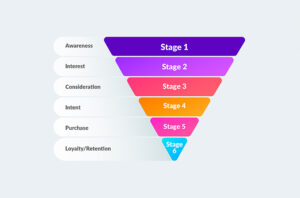What is a sales funnel?
A sales funnel is a visual representation of the steps a prospect takes on their journey from becoming aware of your product or service to becoming a customer. It’s a useful tool for understanding how your marketing and sales efforts are working, and for identifying areas where you can improve.
Importance of sales funnel
Whether you’re a seasoned marketer or just diving into the world of sales, understanding the concept and importance of a sales funnel is the key to driving successful conversions.
Sales funnels are a crucial component of any successful business strategy. They provide a systematic approach to nurturing leads and converting them into paying customers. By understanding the different stages of a sales funnel, businesses can effectively guide prospects through each step of the buying process, increasing the likelihood of conversion. Also, a sales funnel helps to understand the expectations of prospects at each stage and caters to their needs which enhances customer satisfaction.
The stages of the sales funnel

The main advantage of the sales funnel is it can be used to track the progress of prospects through each stage of the buying process. From discovering a product/service to making a purchase, the customer undergoes various stages in between. The sales funnel identifies and segregates the whole customer journey into stages. Below is the detailed breakdown of the sales funnel:
1. Awareness

The awareness stage is where prospects first learn about your product or service. They may see an ad, read a blog post, or hear about it from a friend. At this stage, they are not yet ready to buy, but they are open to learning more.
From the business perspective, businesses focus on generating brand awareness and attracting potential customers. This is where marketing efforts such as content creation, social media advertising, and search engine optimization come into play. By creating valuable and engaging content, businesses try to capture the attention of their target audience and introduce them to their products or services. It is the stage where the potential audience discovers your product/service for the first time.
2. Interest
The interest stage is where customers show their interest in a brand after being aware of it and consume more information regarding a product/service provided by the businesses. At this stage, they are still in the early stages of their buying journey and are not ready to make a purchase yet. However, they are open to learning more about the different options available to them and are interested in hearing from sales representatives.
From the business perspective, this is where businesses aim to cultivate a deeper level of interest in their offerings. They provide more detailed information about their products or services, highlighting the unique benefits and value they provide. This stage often involves lead generation tactics such as offering free trials, demos, or downloadable resources to further engage prospects and encourage them to take the next step.
3. Consideration
In the consideration stage, consumers conduct thorough research, explore different products or services, and weigh their features, benefits, and drawbacks.
They collect information from different brands and often compare offerings from multiple providers. This stage is characterized by a deeper level of engagement and interaction with the content provided by businesses during the interest stage, such as product demonstrations, case studies, and customer reviews.
Marketers play a significant role in influencing consumers’ decisions during this stage by providing them with the information they need to make informed choices. This can be done through advertising, public relations, social media, and other marketing channels.
4. Intent
The intent stage is where prospects evaluate their options and make a final decision. During the intent stage, customers may engage in actions such as requesting price quotes, seeking personalized consultations, or initiating a trial period.
Businesses need to provide compelling reasons why their offering is the best choice. This can be achieved through testimonials, case studies, comparisons with competitors, and clear calls to action. By addressing any objections or concerns that prospects may have, businesses can increase the likelihood of conversion.
5. Action/purchase

Action stage, where prospects become paying customers. This stage involves facilitating a smooth and seamless purchasing process. Businesses need to ensure that their checkout process is user-friendly, secure, and optimized for conversions. This includes offering multiple payment options, providing clear instructions, and minimizing any inconvenience that could discourage prospects from completing their purchase.
6. Retention stage of the sales funnel
While many businesses focus solely on acquiring new customers, the retention stage of the sales funnel is equally important. This stage involves nurturing existing customers and encouraging repeat purchases.
By providing exceptional customer service, personalized offers, and timely ongoing communication, businesses can build long-term relationships with their customers and increase customer loyalty.
Retention strategies can include loyalty programs, exclusive discounts, personalized recommendations, and proactive customer support. By staying top-of-mind and consistently delivering value, businesses can turn one-time buyers into loyal brand advocates who not only make repeat purchases but also refer others to the business.
Optimization and measurement of sales funnels

To ensure the effectiveness of a sales funnel, businesses need to continuously optimize and measure its performance. This involves tracking key metrics at each stage of the funnel and identifying areas for improvement. By analyzing data such as conversion rates, bounce rates, and customer lifetime value, businesses can identify blockages and make data-driven decisions to optimize their funnel.
Conclusion
In conclusion, understanding the concept and stages of a sales funnel is essential for businesses looking to drive successful conversions. By strategically aligning marketing efforts with each stage of the funnel, businesses can guide prospects from initial awareness to final purchase. Additionally, nurturing existing customers and optimizing the funnel through data analysis and testing can further enhance overall sales and profitability.
As we move into 2024, businesses must adapt their sales funnels to the changing landscape of marketing and consumer behavior. By staying informed and continually refining their approach, businesses can leverage the power of sales funnels to achieve their sales and marketing goals and see increased conversions and ROI.
So, whether you’re aiming to boost sales, increase customer retention, or simply enhance your overall marketing strategy, understanding the ins and outs of the sales funnel is the first step. By following the strategies outlined in this guide, you’ll be equipped with the knowledge to understand each stage and the customers’ thought process through their buying journey.


